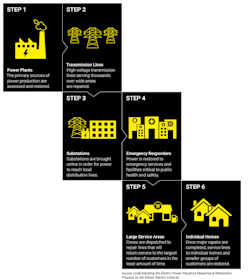Cooperative Reciprocity to Improve Storm Response and Recovery
During the calm before a storm is the best time for utilities to put a plan in place. Otherwise, responders become reactive, which may not yield the best results when the stakes are high. It’s a good time to reflect on past severe weather systems that have hit your area and practice any necessary drills to ensure you and your teams are fully prepared to tackle the weather on the horizon. Identifying storm response priorities, roles, and responsibilities lend confidence in the storm response plan and add assurance for communities who may be concerned about the aftermath.
Mutual Assistance for the Win
During pre-planning, utilities preemptively identify other utilities throughout the country that can be relied on to help rehabilitate the power in the affected areas. It is a shining example of cooperative reciprocity that improves response and recovery. This interchange is known as mutual assistance, defined by the Edison Electric Institute (EEI), an industry trade group, as a voluntary partnership between electric companies nationwide that assist each other to help speed restoration efforts. Also referred to as mutual aid, mutual assistance is imperative to the contingency planning the energy utilities administer prior to every storm season.
There are many benefits to mutual assistance agreements. Not only do they mean more hands to get the work done posthaste, but there are many strategic benefits to the partnership. For one, there are cost efficiencies since the need for additional, full-time utility staff dedicated for emergency situations is eliminated, thanks to better allocation of resources. Stronger relationships are also built among utilities, which facilitates better information sharing within and outside a region’s borders.
Mutual assistance can span beyond the utility industry. Utilities can put plans in place to work with outside contractors, such as emergency responders, tree-trimmers, traffic controllers, and so forth. With augmented restoration support, the linemen tasked with restoring the lost energy can focus on the task at hand in a safer, more efficient way to restore power faster.
Practice Makes Better Strategy
In addition to having the utility teams aligned and a restoration plan in place, it’s crucial to put the strategy to the test. Storm drills, an essential practice for utilities, allow for proper inspection of developed procedures to ensure they’re realistic and can be implemented in a reasonable amount of time. Referencing past storm data and collaborating with other utilities is a great way to share insights and spotlight any holes in the planning.
A simulation is a great way to test efforts first-hand. Members of the Florida Power & Light (FPL) team tested their response capability to a simulated Category 2 hurricane during their annual storm drill in 2016. More than 3000 employees participated in the event.
Though regional needs vary because of different environments and types of storms common to specific geographical locations, the fundamentals of the storm restoration process are generally the same among electric companies. Each one has a detailed plan in place for recovering lost power after a storm. One of the first steps in the process is to ensure power is no longer flowing through downed lines. This helps prevent any additional injuries or fires. The process then follows the list of priorities outlined in the established plans. Reference the outline by the EEI below to see how they break down the antecedents of tasks.
The Storm Restoration Process
To help restore power efficiently after a storm or major power outage, there needs to be a plan and process in place. Below is the EEI’s approach to tackling widespread needs.
Contributed by Flagger Force.

